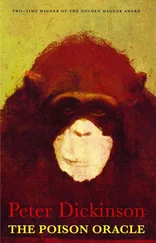Peter Dickinson - Angel Isle
Здесь есть возможность читать онлайн «Peter Dickinson - Angel Isle» весь текст электронной книги совершенно бесплатно (целиком полную версию без сокращений). В некоторых случаях можно слушать аудио, скачать через торрент в формате fb2 и присутствует краткое содержание. Год выпуска: 2006, ISBN: 2006, Издательство: Wendy Lamb Books, Жанр: Старинная литература, на английском языке. Описание произведения, (предисловие) а так же отзывы посетителей доступны на портале библиотеки ЛибКат.
- Название:Angel Isle
- Автор:
- Издательство:Wendy Lamb Books
- Жанр:
- Год:2006
- ISBN:9780375890833
- Рейтинг книги:4 / 5. Голосов: 1
-
Избранное:Добавить в избранное
- Отзывы:
-
Ваша оценка:
- 80
- 1
- 2
- 3
- 4
- 5
Angel Isle: краткое содержание, описание и аннотация
Предлагаем к чтению аннотацию, описание, краткое содержание или предисловие (зависит от того, что написал сам автор книги «Angel Isle»). Если вы не нашли необходимую информацию о книге — напишите в комментариях, мы постараемся отыскать её.
Angel Isle — читать онлайн бесплатно полную книгу (весь текст) целиком
Ниже представлен текст книги, разбитый по страницам. Система сохранения места последней прочитанной страницы, позволяет с удобством читать онлайн бесплатно книгу «Angel Isle», без необходимости каждый раз заново искать на чём Вы остановились. Поставьте закладку, и сможете в любой момент перейти на страницу, на которой закончили чтение.
Интервал:
Закладка:
Fodaro came to his rather different conclusions by very similar means. He was able to observe such things as the formation of stars and the outermost limits of the universe through a very powerful telescope—Benayu’s pool—and the behavior of sub-atomic particles in the form of magical impulses. He was also a mathematical genius. He wasn’t, incidentally, an untaught genius. Before he abandoned his career and took up shepherding he was Imperial Professor of Applied Mathematics at the University of Balin-Balan—the youngest ever to hold that prestigious post. *1He continued his work in his spare time after his retirement and made his breakthrough when his observations of certain magical anomalies led him to the discovery of a place where our four-dimensional universe comes almost, but not quite, into contact with Jex’s seven-dimensional one. He called such places “touching points.”
It is impossible for our four-dimensional minds to imagine what such a universe might be like. We can to some extent describe it with mathematical equations, but we can’t envisage it, can’t form any kind of mind-picture of it. **2
The dimensions of any universe must compose a perfect whole. This means a five-dimensional universe, say, cannot simply have our four plus an extra one, because our four are already a whole and the extra one has nowhere to fit in. This makes it impossible for even one atom of four-dimensional matter to be transferred to a five-dimensional universe, and vice versa. The consequent destruction of matter would involve the creation of energy, as in an atomic explosion.
Sub-atomic particles are another matter. We are already familiar with these in our own universe, in the form, for instance, of the aurora borealis, which is caused by streams of charged particles arriving from the sun and being trapped by the earth’s magnetic field in the ionosphere. Rather more mysterious are the bursts of gamma rays that appear to emanate from the central bulge of our galaxy, and arrive in our atmosphere carrying the extraordinary charge of 511 kilo-electron volts.
Particles of antimatter are created in the big particle colliders, but survive only an instant before they collide with particles of matter, wiping each other out and releasing a burst of energy in the process. Fodaro knew nothing of particle colliders, but was able to use the touching point he found in a very similar fashion, observing the steady leakage of particles from Jex’s universe into ours and measuring the bursts of energy released when they collided with their four-dimensional counterparts and were mutually destroyed. Owing to the inherent weirdness, to our minds, of a seven-dimensional universe, *3this energy took the form of what was known to pre-Fodaran thaumatology as “wild magic.” **4Without understanding its source and nature, over the centuries the magicians of the Empire learned by trial and error to exploit and shape it into a powerful set of tools, usually described as “made magic.”
Pre-Fodaran theory evolved a complex system of “levels” to account for the observed phenomena. Like pre-Copernican astronomy, this worked well enough for most practical purposes, but at the cost of ignoring an increasing number of anomalies and unexplained phenomena, such as the acknowledged difficulty experienced by almost all magicians in progressing from third-level to fourth-level magic. In Fodaran thaumatology this is accounted for as a result of the different degrees of complexity between universes with numbers of dimensions other than our own. First-level magic, “hedge” magic, uses only the impulses from the stray particles inherent in our own universe; second-and third-level magic uses impulses from the simpler two-and three-dimensional universes; fourth-and fifth-level, confusingly, use impulses from universes with five and six dimensions, and sixth-level uses impulses from any universes beyond that.
Certain people are born with innate magical power. This is something like a magnetic field, in that it can capture the magical impulses from other universes. The stronger the field, the greater the number and variety of the impulses it can capture. But a magician cannot use it until he or she has learned to control and shape the flow of impulses within the field. What in pre-Fodaran thaumaturgy was called wild magic was the result of random and transient combinations of impulses; made magic was produced by magicians using their craft; while natural magic arose from certain combinations in wild magic that turned out to have survival value and evolved of their own accord into more and more complex forms, such as dragons and unicorns.
Demons are another matter. Most of them arise from attempts by ambitious magicians to shape and control some phenomenon of natural magic for their own purposes. This then proves to be beyond their powers, and they themselves are absorbed into the result. Since their original motive for making the attempt was almost invariably bad, the resulting monster is more or less powerfully malign. Angels arise from well-intentioned but failed attempts to do the same thing. Hence their rarity.
Further information can be found on the Web site of the Thaumatological Department at the University of Balin-Balan.
FOOTNOTES
*1The prestige of course derives from the fact that the field to which the mathematics is applied is magic.
Return to text.
**2We are more familiar with this sort of thing than we realize. It is impossible to imagine the square root of minus one, but formulae that involve it can have important practical results, such as the atom bomb.
Return to text.
*3It is perhaps worth noting that we have intuitively designated seven as the magical number.
Return to text.
**4In pre-Fodaran thaumaturgy wild magic was thought to be released whenever someone died. This is only partly true. It can come from other sources, including touching points, but the death of any living creature involves the departure of the individual anima into hyperspace, with a compensating flow of energy in the reverse direction.
Return to text.
About the Author
Peter Dickinson is the author of many books for adults and young readers and has won numerous awards, including the Carnegie Medal (twice), the Guardian Award, and the Whitbread Award (also twice). The Ropemaker was a Michael L. Printz Honor Book for excellence in young adult literature, an ALA Best Book for Young Adults, and winner of the Mythopoeic Society Children’s Fantasy Award. Dickinson’s novel Eva was a Boston Globe–Horn Book Fiction Honor Book. Eva was also selected as an ALA Best Book for Young Adults, as were Dickinson’s novels AK and A Bone from a Dry Sea. His most recent book for Random House was Inside Grandad. Peter Dickinson has four grown children and lives in Hampshire, England, with his wife, the writer Robin McKinley.
BY THE SAME AUTHOR
FOR YOUNG PEOPLE:
Inside Grandad
The Tears of the Salamander
The Ropemaker
The Kin
The Lion Tamer’s Daughter
and Other Stories
Chuck and Danielle
Shadow of a Hero
Time and the Clock Mice, Etcetera
A Bone from a Dry Sea
AK
Eva
Merlin Dreams
A Box of Nothing
Giant Cold
Healer
The Seventh Raven
City of Gold
and Other Stories from the Old Testament
Tuklu
Hepzibah
Annerton Pit
The Blue Hawk
The Gift
The Dancing Bear
Emma Tupper’s Diary
THE CHANGES TRILOGY:
The Weathermonger
Heartsease
The Devil’s Children
Published by Wendy Lamb Books
an imprint of Random House Children’s Books
a division of Random House, Inc.
New York
Читать дальшеИнтервал:
Закладка:
Похожие книги на «Angel Isle»
Представляем Вашему вниманию похожие книги на «Angel Isle» списком для выбора. Мы отобрали схожую по названию и смыслу литературу в надежде предоставить читателям больше вариантов отыскать новые, интересные, ещё непрочитанные произведения.
Обсуждение, отзывы о книге «Angel Isle» и просто собственные мнения читателей. Оставьте ваши комментарии, напишите, что Вы думаете о произведении, его смысле или главных героях. Укажите что конкретно понравилось, а что нет, и почему Вы так считаете.








